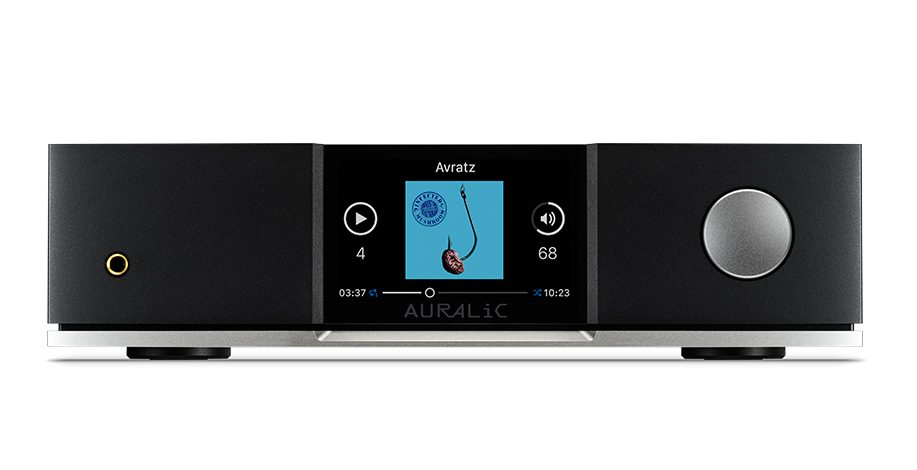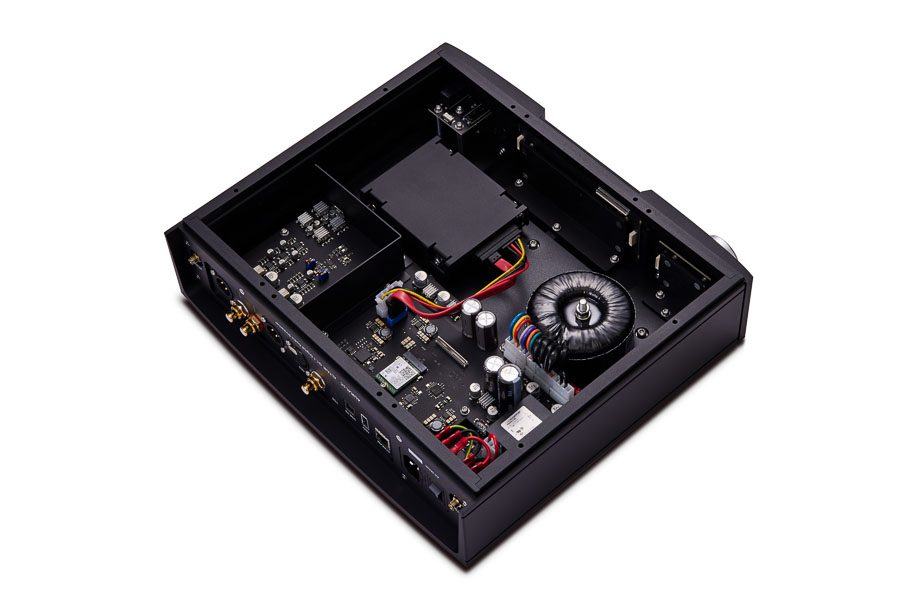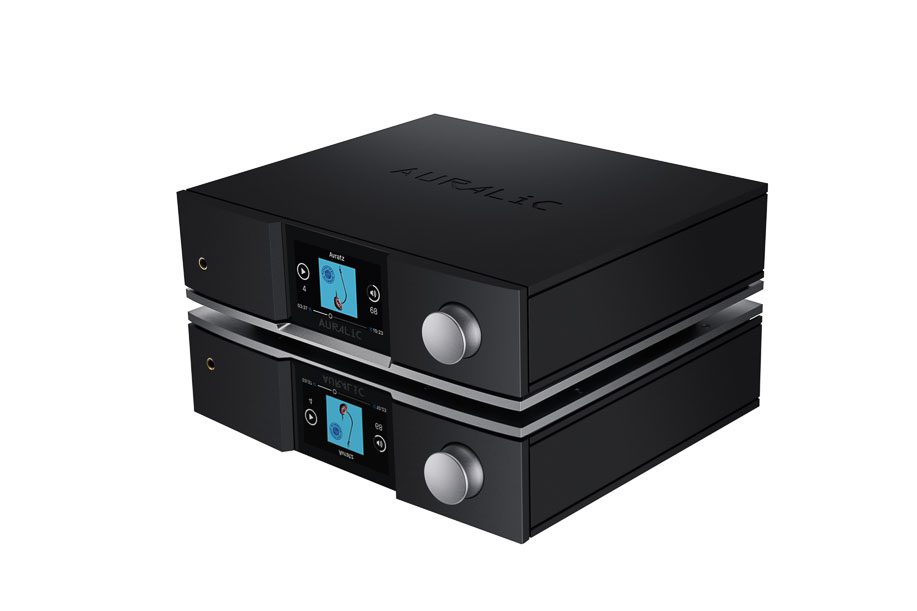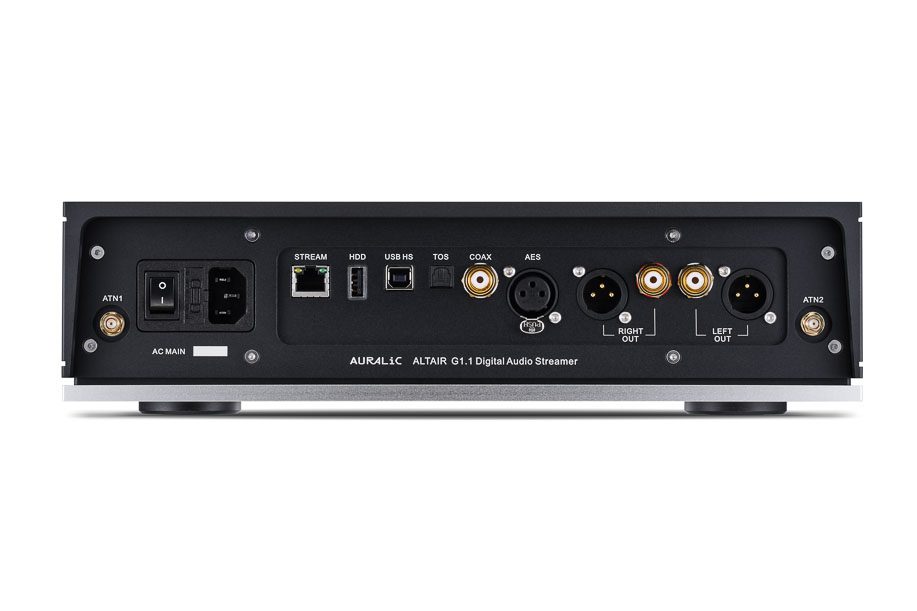
With the ALTAIR G1.1 AURALiC has made small but significant revisions to its entry-level one-box streamer/DAC/preamplifier. Next to the preceding ALTAIR G1, the most obvious of these is the addition of an extra base plate; finished in anodised silver for greater visibility. We looked at the ARIES G1.1 in Issue 213; this is a dedicated streamer in a very similar case that has had the same upgrades as the new ALTAIR G1.1. The two are differentiated by the presence of a knob on the ALTAIR G1.1, which acts as a volume control as well as a means of navigating the on-screen menu.
A new base plate may not seem to be much of a change, but it brings the casework closer to that of the G2.1 range topping AURALiCs and increases the rigidity of the box considerably. Vibration clearly influences the sound of audio electronics, even where there are no moving parts; you only have to compare the effects of different types of feet on a DAC to hear as much. Other changes brought in for G1.1 include the option to add a hard drive for music storage, a femto clock for the processor, the introduction of Vtuner for internet radio and the option to use an external disc drive for playback and ripping of CDs.
The similarity between models in the AURALiC range makes them a little tricky to tell apart for the uninitiated, but does give a brand consistency that means that they stack together nicely if you go down the multi-box route. Build quality is of a very high standard, the cases are fabricated from machined aluminium with not a fixing in sight until you get to the back panel.
Ready for audio action
The ALTAIR G1.1 has a high feature count and is ready to work with the vast majority of signal formats and sources in the digital realm. At its core is the Lightning streaming platform that connects via ethernet or wirelessly to the local network and can stream from a wide variety of providers including the usual suspects Qobuz and Tidal alongside less common sources including Amazon Music and Highresaudio. Both Tidal and Spotify Connect are catered for as well as Bluetooth and Airplay 2 for mobile devices should you want to abandon sound quality in exchange for marginal ease of use gains.
AURALiC’s Lightning platform is driven by the company’s Lightning DS control app, currently only for iOS devices. This is a nicely designed piece of software that is regularly updated to bring in additional features and services. It has particularly well sorted interfaces for Qobuz and Tidal which make it easy to find ‘favorites’, see new releases and search for specific artists or titles. With local collections you can look at your music by artist, album, genre etc as well as release date, import date and file type. The internet radio is well done too with easy search and pre-setting by hitting the ‘favorite’ heart. Making playlists and sharing chosen tracks via the usual apps is also straightforward.
Diving deeper
Deeper in the app are settings including alternative digital filters, parametric EQ, volume settings, balance, output level and configuration for automatically scanning the local drive so that new albums or tracks show up in the library. You can have the display on all the time, which can undermine sound quality, or have it on for a chosen time before dimming. Given that nearly all controls are done with the app you don’t really need to see album art on the ALTAIR’s display. Volume can be controlled with a slider on the app but this takes a fine touch to do precisely, it’s preferable to teach the ALTAIR the commands from a spare remote control using the menu on the machine. This is a slightly painful process because the text is so small on the display but it doesn’t take long and allows all manner of functions to be learned, including one that is not apparently an option elsewhere, namely power on and off. One small gripe is that the iOS device running the app remains on unless turned off; if you’re not careful this can mean the iPad is down to 10% in surprisingly little time.

When the play page is shown in the app it reveals that all incoming PCM signals are upsampled to 32-bit, this is fixed as far as can be told with no option to turn it off. It is possible to raise or lower the sample rate within settings should you feel the inclination. Of more interest is the option to add a drive to the ALTAIR and create an onboard music library that benefits from a very short signal path to the processor and can be had for a much lower price than a standalone music server. Having server software onboard comes into its own here; most streamers do not offer server functions and only show the crude metadata stored on USB drives. Lightning server software presents it in the same well organised way that it does with a streaming service or audio server.
On the connections front the ALTAIR G1.1 has the full gamut of digital inputs from USB through S/PDIF to AES, there is no HDMI for video but this is a dedicated audio product after all. It has a USB input for appropriate drives and both ethernet and twin aerial fixings for network connection. The analogue outputs are in both balanced and single-ended form with their output optionally fixed or volume controlled. I tried balanced initially but the output level proved too high and caused the power amp to clip, so all listening via a preamp was with the single ended RCA outputs. I later learnt that the output from either connection can be reduced by up to 12dB in the app.
Sonic compulsion
The ALTAIR G1.1 shares an entirely even-handed and neutral presentation with the rest of the AURALiC range. There is very little character to the sound and as a result it reflects the nature of the music being played with a high degree of accuracy. The entry-level ALTAIR isn’t as refined as the more expensive offerings in the catalogue and this can be heard in lower resolution of quiet details, and not quite so much finesse in the high frequencies, but in the context of its price, this is an extremely powerful and effective device for enjoying streamed music.
It sounded quite relaxed after the ARIES G1/iFi Pro iDSD Signature streamer and DAC combo that preceded it, but the music was no less compelling for it, particularly with Slint’s angsty vibes on the gritty Spiderland. An album that can become a bit too edgy on some systems yet which flowed rather well via the ALTAIR G1.1. The bass on this streamer is on the generous side which is great with a wide variety of music, from the post rock of Slint to the smooth yet complex rhythms and melodies of Herbie Hancock and Joni Mitchell. Their take on ‘The Man I Love’ is clearly a plush recording and you can stretch out and relax to the way that these veterans make the most of a Gershwin standard.

I found a great piece of music on YouTube recently, Michael Manring’s ‘Selene’ is a solo bass tune with some highly proficient playing put to great melodic use. Fortunately the track is also available on Qobuz and the ALTAIR delivered it with impressive image depth, the sound being almost entirely behind the speakers and somehow opening up beyond the wall.
As previously mentioned, adding a local library to the Lightning server is a slightly painful process requiring the input of a network path to the relevant storage. But this approach does mean that you can add as many different libraries as you have access to including those on USB, something that only Roon can do with most streamers. The ALTAIR is Roon Ready but there isn’t a huge advantage in taking that approach beyond the relatively high reliability and richer background info of that system. In sound quality terms Lightning DS has the edge however and that’s ultimately what this component is all about.
Deep and even
Timing is another AURALiC strongpoint and the ALTAIR G1.1 does not disappoint in this department, this was evidenced on Bob Marley’s ‘Natural Mystic’ a track chosen to check out the weight and power of the deep bass notes that punctuate it at almost random intervals. But the tightness of the rhythm proved far too inspiring to be distracted by heavy notes now and then, they were there but that’s not the point of the piece. Also apparent was the depth of reverb on the guitar, this usually sounds fairly flat and sharp but the ALTAIR showed that it has a distinct shape and timbre.
The above was discovered with the streamer’s single ended outputs connected to a Townshend Allegri Reference preamp which fed the signal to a Moor Amps Angel 6 power amp. Removing the preamp from this chain and using the balanced outputs directly to the power amplifier didn’t prove too costly a change in sound terms, the onboard volume control isn’t as transparent but it’s capable of delivering strong results. The absence of any analogue inputs does limit its functionality in this situation but for those dedicated to digital it’s a very serviceable approach that cuts down on boxes without much sonic compromise.
Running the ALTAIR wirelessly doesn’t reduce its musicality too obviously and I enjoyed a lot of background music with it set up this way. However, making the comparison between over air and over (carefully selected) ethernet did make a strong case for wiring this streamer into a decent network switch. The ethernet approach brought distinct gains in terms of focus and precision of image thanks to a reduction in the noise floor and the clarity of low level detail which that produces.

I also contrasted the internal HDD with my network server which is a fine example of the breed. Here the direct connection of the onboard storage gave it a clear advantage in terms of timing, it didn’t have the tonal finesse of the outboard server but more than made up for this with a more engaging presentation. Which is a pretty strong result for something that costs a couple of hundred pounds to have installed by a dealer, and capacity is only limited by what can be had in a SATA drive. There is also the option to use an SSD with its potential for lower noise and thus higher resolution.
Easy and expressive
Using a standalone streamer and feeding the USB input on the ALTAIR proved that the DAC on the AURALiC is a pretty decent example of the art. AURALiC mention that they eliminate one source of noise by bypassing the 5V that accompanies the signal and provide power for this input with an onboard linear supply. The USB input is capable of fine results, it along with the DAC are clearly transparent to the quality of the incoming signal and produced an easy, calm and expressive result that bodes well for any external source. With a component like the ALTAIR there isn’t much you can add that isn’t already catered for onboard of course but who knows what’s waiting around the corner. When it comes to future proofing, AURALiC has proved to be rather better than average over the years. All of AURALiC’s products past and present can be upgraded to the latest firmware. This means that a service like Amazon Music which wasn’t around five years ago at the time of the G1 and G2 series components is now available through them. And this applies right back to the original curvy plastic ARIES streamers that the brand launched with, it’s one reason why those units hold their value nearly ten years on.
Verdict
Anyone looking for a one box streaming source should put the ALTAIR G1.1 high on their short list. It has all the features you need including headphone output, it’s solidly built and finished to a high standard. Add to this the onboard storage option and one of the cleanest control apps in the game and you have a streamer that is both musically enthralling and ready for almost anything that turns up in the digital streaming multiverse.
Technical specifications
- Type: Solid-state network streamer, DAC, digital preamplifier with headphone amp
- Analogue Inputs: none
- Digital Inputs: One coaxial S/PDIF (via RCA jack), one TOSLink, one AES/EBU, one USB B, one USB A
- DAC Resolution/Supported Digital Formats: FLAC/WAV/MP3, etc. Sampling rate for D/A conversion 384kHz/32 bit, DSD512
- Music services/Wi-Fi inputs: Amazon Music Unlimited, HighResAudio, KKBOX, Qobuz Sublime+, NetEase Music, TIDAL Connect, Spotify Connect, Internet Radio, AirPlay 2, RoonReady, Bluetooth
- Analogue Outputs: One stereo balanced (via XLR connectors), one stereo unbalanced (via RCA jacks)
- Digital Outputs: none
- Frequency Response” 20–20KHz, +/- 0.1dB
- Distortion (THD + Noise): < 0.0002% (XLR); < 0.0003% (RCA), 20Hz-20KHz at 0dBFS
- User Interface: 4 inch display (on main unit), AURALiC Lightning application software for iOS
- Dimensions (H×W×D): 80 × 340 × 320mm
- Weight: 7.4kg
- Price: £2,699
Manufacturer
AURALiC
+44 (0)7590 106105
By Jason Kennedy
More articles from this authorRead Next From Review
See all
PrimaLuna EVO 100 phono preamplifier
- Apr 22, 2024

Reiki Audio SuperSwitch Master Pro + Servant Pro
- Mar 27, 2024

Melco Audio N1-S38 music server
- Mar 27, 2024











